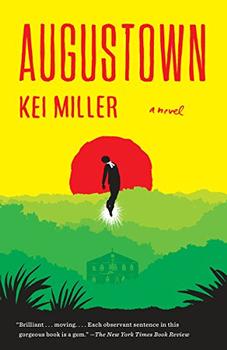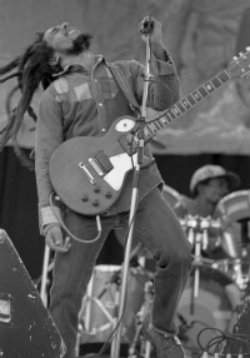Summary | Excerpt | Reading Guide | Reviews | Beyond the Book | Read-Alikes | Genres & Themes | Author Bio

This article relates to Augustown
In the acknowledgments in Augustown, Kei Miller reveals that the novel was inspired by a story told to him by fellow poet Ishion Hutchinson, who had his dreadlocks cut off by a teacher when he was a young boy in Jamaica. Wearing dreadlocks and the ritual smoking of marijuana are two well-known practices in Rastafarianism, an Abrahamic religion that developed in Jamaica in the 1930s in response to colonialism. It is a monotheistic faith based on a literal interpretation of the Bible and strict devotion to God, known as "Jah" (pronounced Yah, short for Yahweh).
 The religion is also inspired by African history with Haile Selassie recognized as God incarnate on earth, and Africa is seen as a Promised Land for resettlement. There is some debate about whether Haile Selassie, emperor of Ethiopia from 1930 to 1974, embraced his role as deity. Figures like Marcus Garvey, a Jamaican political leader in the early twentieth century, encouraged that "Back to Africa" ideal as a way of redressing the forced migration of blacks via the international slave trade. Bob Marley helped spread Rastafarianism around the world in the 1970s. There are now estimated to be 1 million practitioners. Other Rastafarian customs include communal living; drumming and chanting to enter a state of meditation; heavy use of the colors red, green, and gold; abstaining from alcohol and pork; and eating a natural (usually vegetarian) diet.
The religion is also inspired by African history with Haile Selassie recognized as God incarnate on earth, and Africa is seen as a Promised Land for resettlement. There is some debate about whether Haile Selassie, emperor of Ethiopia from 1930 to 1974, embraced his role as deity. Figures like Marcus Garvey, a Jamaican political leader in the early twentieth century, encouraged that "Back to Africa" ideal as a way of redressing the forced migration of blacks via the international slave trade. Bob Marley helped spread Rastafarianism around the world in the 1970s. There are now estimated to be 1 million practitioners. Other Rastafarian customs include communal living; drumming and chanting to enter a state of meditation; heavy use of the colors red, green, and gold; abstaining from alcohol and pork; and eating a natural (usually vegetarian) diet.
Rastafarians justify the wearing of dreadlocks with a passage from scripture, Numbers 6:5: "All the days of his vow of separation, no razor shall touch his head. Until the time is completed for which he separates himself to the Lord, he shall be holy. He shall let the locks of hair of his head grow long." Rastafarians thus make the same Nazirite vow as Samson did in the book of Judges; their hair is considered a source of strength and a metaphorical link with the lion, a Rasta symbol.
However, Rastafarians are not the only group to have worn dreadlocks. Dreadlocks are mentioned in the Hindu Vedas and were worn by Ancient Egyptians, Greeks, Celts, and Pacific Islanders. During the Mau Mau rebellion in Kenya in the 1950s, members of the Mau Mau tribe wore dreadlocks to inspire "dread" (a deliberate etymological link in the choice of name back in Jamaica) in their British colonizers.
In recent decades dreadlocks have become something of a mainstream fashion statement, worn not just by Rastafarians. Dreadlocks still carry political connotations of rebellion against the system, though, so have been a popular choice for hippies. Dreads may still be considered "dirty" and/or threatening, and forcibly cutting them off (e.g. in prison or before entering the Army) is a means of ensuring conformity. Things are slowly changing, though: as of early 2017, the U.S. Army allows small, neat dreadlocks on female soldiers. This joins a set of special dispensations that can be made for beards, turbans, and hijabs worn for religious reasons.
White people wearing dreadlocks remains controversial. A viral video taken at San Francisco State University in March 2016 shows African-American student Bonita Tindle confronting white student Cory Goldstein for wearing dreads and accusing him of cultural insensitivity.
Apart from the context of Rastafarianism, are dreadlocks a sign of mistaken cultural appropriation, or an acceptable form of personal expression? The debate continues.
Filed under Places, Cultures & Identities
![]() This "beyond the book article" relates to Augustown. It originally ran in May 2017 and has been updated for the
May 2018 paperback edition.
Go to magazine.
This "beyond the book article" relates to Augustown. It originally ran in May 2017 and has been updated for the
May 2018 paperback edition.
Go to magazine.
The only real blind person at Christmas-time is he who has not Christmas in his heart.
Click Here to find out who said this, as well as discovering other famous literary quotes!
Your guide toexceptional books
BookBrowse seeks out and recommends the best in contemporary fiction and nonfiction—books that not only engage and entertain but also deepen our understanding of ourselves and the world around us.